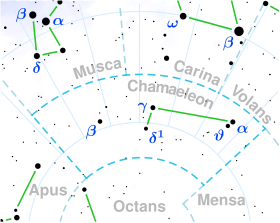Astronomy:HD 101917
| Observation data Equinox J2000.0]] (ICRS) | |
|---|---|
| Constellation | Chamaeleon |
| Right ascension | 11h 42m 54.93206s[1] |
| Declination | −79° 18′ 23.0075″[1] |
| Apparent magnitude (V) | 6.38±0.01[2] |
| Characteristics | |
| Spectral type | K0 III/IV[3] |
| U−B color index | +0.59[4] |
| B−V color index | +0.90[4] |
| Astrometry | |
| Radial velocity (Rv) | 32.5±0.4[5] km/s |
| Proper motion (μ) | RA: +127.152[1] mas/yr Dec.: −11.599[1] mas/yr |
| Parallax (π) | 17.64 ± 0.0224[1] mas |
| Distance | 184.9 ± 0.2 ly (56.69 ± 0.07 pc) |
| Absolute magnitude (MV) | +2.69[6] |
| Details | |
| Mass | 1.26[7] M☉ |
| Radius | 4.01±0.20[8] R☉ |
| Luminosity | 9.04±0.03[1] L☉ |
| Surface gravity (log g) | 3.32±0.06[9] cgs |
| Temperature | 5,076±19[9] K |
| Metallicity [Fe/H] | −0.11±0.02[9] dex |
| Rotational velocity (v sin i) | <1.4[10] km/s |
| Age | 3.87+0.41−0.42[1] Gyr |
| Other designations | |
| Database references | |
| SIMBAD | data |
HD 101917, also designated as HR 4509, or rarely 34 G. Chamaeleontis,[12] is a solitary star located in the southern circumpolar constellation Chamaeleon. It has an apparent magnitude of 6.38,[2] placing it near the limit for naked eye visibility. The object is located relatively close at a distance of 185 light years based on Gaia DR3 parallax measurements[1] but is receding with a heliocentric radial velocity of 33 km/s.[5] At its current distance, HD 101917's brightness is diminished by 0.28 magnitudes due to interstellar dust.[13] It has an absolute magnitude of +2.69.[6]
HD 101917 has a stellar classification of K0 III/IV,[3] indicating that it is an evolved K-type star with the blended luminosity class of a subgiant and a giant star. Gaia DR3 models it to be 3.9 billion years old,[1] enough time for it to cool and expand to 4.01 times the radius of the Sun.[8] At present it has 126% the mass of the Sun[7] and now radiates 9.04 times the luminosity of the Sun from its enlarged photosphere at an effective temperature 5,076 K,[9] giving it a yellow hue. HD 101917 has an iron abundance 22% below solar levels,[9] making it slightly metal deficient. It spins slowly with a projected rotational velocity lower than 1.4 km/s.[10]
References
- ↑ 1.0 1.1 1.2 1.3 1.4 1.5 1.6 1.7 Vallenari, A. et al. (2022). "Gaia Data Release 3. Summary of the content and survey properties". Astronomy & Astrophysics. doi:10.1051/0004-6361/202243940 Gaia DR3 record for this source at VizieR.
- ↑ 2.0 2.1 Høg, E.; Fabricius, C.; Makarov, V. V.; Urban, S.; Corbin, T.; Wycoff, G.; Bastian, U.; Schwekendiek, P. et al. (March 2000). "The Tycho-2 catalogue of the 2.5 million brightest stars". Astronomy and Astrophysics 355: L27–L30. ISSN 0004-6361. Bibcode: 2000A&A...355L..27H.
- ↑ 3.0 3.1 Houk, N.; Cowley, A. P. (1975). University of Michigan Catalogue of two-dimensional spectral types for the HD stars. Volume I. Declinations −90° to −53°. Bibcode: 1975mcts.book.....H.
- ↑ 4.0 4.1 Johnson, H. L.; Mitchell, R. I.; Iriarte, B.; Wisniewski, W. Z. (1966). "UBVRIJKL Photometry of the Bright Stars". Communications of the Lunar and Planetary Laboratory 4: 99–110. Bibcode: 1966CoLPL...4...99J.
- ↑ 5.0 5.1 Gontcharov, G. A. (November 2006). "Pulkovo Compilation of Radial Velocities for 35 495 Hipparcos stars in a common system". Astronomy Letters 32 (11): 759–771. doi:10.1134/S1063773706110065. ISSN 1063-7737. Bibcode: 2006AstL...32..759G.
- ↑ 6.0 6.1 Anderson, E.; Francis, Ch. (May 2012). "XHIP: An extended hipparcos compilation". Astronomy Letters 38 (5): 331–346. doi:10.1134/S1063773712050015. ISSN 1063-7737. Bibcode: 2012AstL...38..331A.
- ↑ 7.0 7.1 Anders, F. et al. (August 2019). "Photo-astrometric distances, extinctions, and astrophysical parameters for Gaia DR2 stars brighter than G = 18". Astronomy & Astrophysics 628: A94. doi:10.1051/0004-6361/201935765. ISSN 0004-6361. Bibcode: 2019A&A...628A..94A.
- ↑ 8.0 8.1 Kervella, P.; Thévenin, F.; Di Folco, E.; Ségransan, D. (October 2004). "The angular sizes of dwarf stars and subgiants". Astronomy & Astrophysics 426 (1): 297–307. doi:10.1051/0004-6361:20035930. ISSN 0004-6361. Bibcode: 2004A&A...426..297K.
- ↑ 9.0 9.1 9.2 9.3 9.4 Hojjatpanah, S. et al. (September 2019). "Catalog for the ESPRESSO blind radial velocity exoplanet survey". Astronomy & Astrophysics 629: A80. doi:10.1051/0004-6361/201834729. ISSN 0004-6361. Bibcode: 2019A&A...629A..80H.
- ↑ 10.0 10.1 De Medeiros, J. R.; Alves, S.; Udry, S.; Andersen, J.; Nordström, B.; Mayor, M. (January 2014). "A catalog of rotational and radial velocities for evolved stars". Astronomy & Astrophysics 561: A126. doi:10.1051/0004-6361/201220762. ISSN 0004-6361. Bibcode: 2014A&A...561A.126D.
- ↑ "HD 101917". SIMBAD. Centre de données astronomiques de Strasbourg. http://simbad.u-strasbg.fr/simbad/sim-basic?Ident=HD+101917.
- ↑ Gould, Benjamin Apthorp (1878). "Uranometria Argentina : brillantez y posicion de las estrellas fijas, hasta la septima magnitud, comprendidas dentro de cien grados del polo austral : con atlas". Resultados del Observatorio Nacional Argentino 1. Bibcode: 1879RNAO....1.....G.
- ↑ Gontcharov, George A.; Mosenkov, Aleksandr V. (28 September 2017). "Verifying reddening and extinction for Gaia DR1 TGAS main sequence stars". Monthly Notices of the Royal Astronomical Society 472 (4): 3805–3820. doi:10.1093/mnras/stx2219. ISSN 0035-8711. Bibcode: 2017MNRAS.472.3805G.
 |


